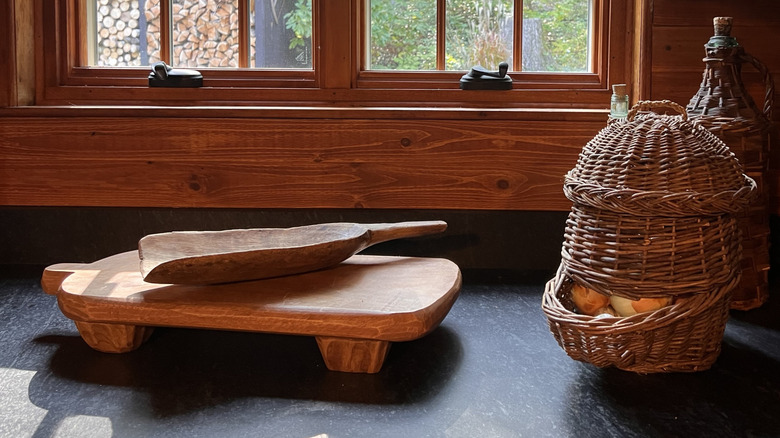Why You Might Want To Consider Soapstone Countertops If You Cook A Lot
We may receive a commission on purchases made from links.
When exploring countertop options, you'll likely come across aesthetically pleasing soapstone, prized for its sleek understated beauty and ability to blend into most kitchen design schemes. But a deeper dive into this surprisingly sturdy material reveals the real superpower of soapstone: an extraordinary level of heat resistance. Imagine pulling a sizzling pan off the stove, plopping it directly onto your kitchen counter, and leaving no burn marks or other repercussions.
The word "soap" in the name of this resilient stone is misleading, as it has nothing to do with the household cleaning agent, other than its smooth soap-like texture. Also known as steatite, soapstone is essentially a talc-rich metamorphic rock that's popular for building fireplaces. It's also used to make high-quality pizza stones, griddles, and other cookware as well as ceramic drinkware. Soapstone kitchen counters can handle heat without scorching or warping, and there's no need for hot pads, trivets, or heat-resistant pads.
In addition to its heat tolerance, soapstone is tough enough to handle the weight of hot and heavy pans that fly from stovetop to countertop when the cooking's done. Compared to other well-known countertop materials, such as quartz, soapstone is less likely to crack when experiencing sudden temperature changes, an anomaly known as thermal shock. Another plus is that natural-stone properties of soapstone don't react to acidic ingredients such as vinegar and lemon juice, so there's less concern over etching or fade spots. If you do a lot of cooking, this is definitely a material to keep on your remodeling radar.
So many surprising soapstone attributes
Though heat resistance is a major attribute of soapstone, it's not the only one, by far. Since the stone is naturally nonporous, it resists stains from coffee, wine, or grease. There's no need for sealing as with marble or granite. Since no food particles or liquids soak into the surface, it's not a breeding ground for bacteria buildup. Cleaning is easy, typically just soap and water, so you can ditch the harsh chemicals and special stone cleaners.
Soapstone remains mostly in its natural state when quarried, requiring very little resources, fabrication, finishing, or processing before landing in kitchens. The environmental impact is subsequently very low compared to harder stones pulled from deeper in the earth. Soapstone is also considered recyclable and can be easily repurposed. Yes, it's a wonder-world material, but choosing soapstone does come with considerations. It tends to accumulate scratches and light dents, though it's simple to sand them down, creating a pleasing weathered patina over time. Some people choose to protect the counters with a food-safe product like The Original Soapstone Wax.
Soapstone counters can be more expensive upfront than those made with mainstream materials. As a natural dimension stone, the counters can withstand decades of use, making them a wise and attractive long-term investment. They only come in a handful of natural basic colors, mostly blacks, blues, grays, and sometimes white or green — so they'll likely fit future interior-design schemes. When spending a lot of time in the kitchen, soapstone pretty much rings all the bells.

